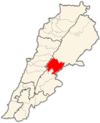Place in Beqaa, Lebanon
| Karak كرككرك نوح | |
|---|---|
 | |
| Coordinates: 33°51′0″N 35°55′35″E / 33.85000°N 35.92639°E / 33.85000; 35.92639 | |
| Country | Lebanon |
| Governorate | Beqaa |
| District | Zahlé |
| Time zone | GMT +2 |
| • Summer (DST) | +3 |
| Area code | (+961) 8 |
Karak (also Kerak, Karak Nuh or Karak Noah) (Arabic: كرك, romanized: Karak) is a village in the municipality of Zahlé in the Zahle District of the Beqaa Governorate in eastern Lebanon. It is located on the Baalbek road close to Zahle. Karak contains a sarcophagus claimed by the locals to be the tomb of Noah. The inhabitants of Karak are Melkites, Maronites and Shia Muslims.
History
The town was an important religious site during the Middle Ages, drawing devotion from the local rural village communities. The town was known as al-Karak during the time of the Ayyubid dynasty and changed to Karak Nuh under the Mamluks.
In medieval period, the Shia muhaddith Ahmad bin Tariq bin Sinan (b. 1132) was born in the town. In the mid-13th century, the settlement to the north of Karak Nuh, Bḥaouchiyya, was inhabited by Tanukhid emirs from Mount Lebanon who practiced the Shia faith. Karak Nuh gradually became known as a center of learning for Shia Islam and the administrative centre of the southern Beqaa. Under the Mamluks Karak Nuh served as the administrative center of southern Beqaa. Damascene historian Shams al-Din ibn Tulun (1475–1546), who visited the town noted that "its people were famous for their Shia faith".
A Safavid sheikh, Ali al-Karaki, and various dignitaries were born in the town. In 1533–1548, the town was the second largest in the Beqaa valley after Baalbek, comprising 590 households, all Muslims. The town was largely devastated in strife between the Yunus Harfush and Fakhreddine in 1623 and as a result was abandoned for several decades, with many of its inhabitants moving to Jabal Amel.
A major earthquake damaged the town's distinguishing minaret in 1705, which required repair by the 'Alwan family.
In 1838, Eli Smith noted el-Kerak's population being Metawileh and Catholics.
Tomb of Noah
According to tradition mentioned by al-Mukaddasi and Al-Dimashqi, the tomb of Noah existed in the tenth century and can still be seen. The stone tomb measures around 104.8 feet (31.9 m) long, 8.7 feet (2.7 m) wide and 3.2 feet (0.98 m) high and is covered in a worn green cloth. It is housed in a room measuring 10.1 feet (3.1 m) by 8.1 feet (2.5 m). There is a chapel next to the cenotaph building where several inscriptions (decrees) dating to the fourteenth century were found. There is also a courtyard outside the building with a prayer niche. The size of the monument possibly derives from tales of ancient giants, but is more realistically suggested to be a section of an ancient aqueduct that has been converted to serve as a shrine.
Archaeology
A Roman inscription in Latin dating to the year 84 CE was found in the basement of a house to the south west of the tomb that called for the long life of the "man with many names".
Locale
Near to the town is the Ayn al-Garr spring and Massyas lake and marshes that are considered to be the source of the Litani river.
Notable people
- Muhammad al-Harfushi (d. 1649), cloth-maker, Arabic grammarian and poet from Karak Nuh who was persecuted for his Shia faith in Damascus and then moved to Iran where he received an official state post
- Husayn al-Mujtahid al-Karaki, Shia scholar and maternal descendant of Muhaqqiq al-Karaki, served as Shaykh al-Islām of Qazvin and Ardabil
See also
References
- "Zahleh - Maallaqa - Taanayel". Local Liban. 22 February 2006. Retrieved 5 October 2020.
- ^ Winter, 2010, p. 43 ff
- "Municipal and ikhtiariah elections in the Beqa'a 147 municipalities and 414 mokhtars" (PDF). The Monthly Magazine. February 2010. Archived from the original (PDF) on 4 March 2016.
- Sourdel, D., " Karak Nūḥ." Encyclopaedia of Islam, Second Edition. Brill Online , 2012. Reference. 3 October 2012
- Yunini, Qutb ad-Din. Dhayl mir'at al zaman.
- Khalife, Issam (2004). The Districts of Lebanon in The 16th Century (in Arabic). p. 125.
- Ḥamādah, Saʻdūn (2008). The History of Shiites in Lebanon, Volume one (in Arabic). Dar Al Khayal. ISBN 9789781025488.
{{cite book}}: CS1 maint: location missing publisher (link) - Robinson and Smith, 1841, vol 3, 2nd appendix, p. 143
- Le Strange, 1890, p. 480
- ^ Royal Anthropological Institute of Great Britain and Ireland (1871). Journal. p. 323.
- Ḥaddād, 1956, p. x
- Sourdel-Thomine, Janine, 'Inscriptions arabes de Karak Nuh', Bulletin d'Etudes Orientates, 13: 71-84, (1949–51)
- Burton, p. 40 ff
- Lipiński, 2000, p. 307 ff
Bibliography
- Burton, R. F. A Plain and Literal Translation of the Arabian Nights Entertainments, Vol. 7 of 10: The Book of the Thousand Nights and a Night. Forgotten Books. ISBN 978-1-4400-4321-5.
- Ḥaddād, Jūrj Marʻī (1956). Baalbak, North & South Lebanon: Description, history and touristic guide. Printed by el-Hashimieh Press.
- Le Strange, G. (1890). Palestine Under the Moslems: A Description of Syria and the Holy Land from A.D. 650 to 1500. Committee of the Palestine Exploration Fund.
- Lipiński, E. (2000). The Aramaeans: Their Ancient History, Culture, Religion. Peeters Publishers. p. 307. ISBN 978-90-429-0859-8.
- Robinson, E.; Smith, E. (1841). Biblical Researches in Palestine, Mount Sinai and Arabia Petraea: A Journal of Travels in the year 1838. Vol. 3. Boston: Crocker & Brewster.
- Winter, S. (2010). The Shiites of Lebanon under Ottoman Rule, 1516-1788. Cambridge University Press. ISBN 978-0-521-76584-8.
External links
- Photo of the inside of the Tomb of Noah on Flickr
- Tomb of Noah (with photos) on the blog of John Sanidopoulos
- Photo of Karak Nuh, minaret and the outside of the Tomb of Noah on Photobucket
| Capital: Zahlé | ||
| Towns and villages |  | |
| Other | ||